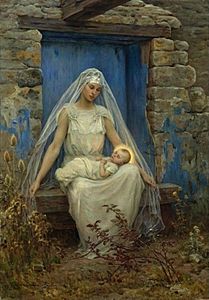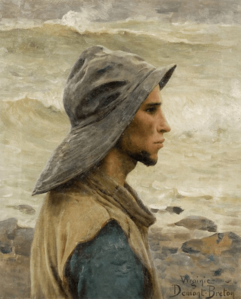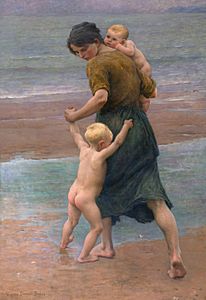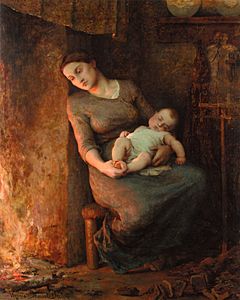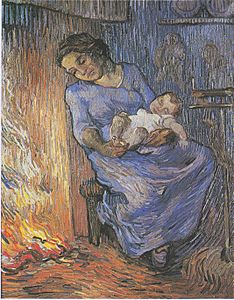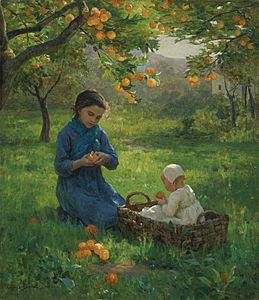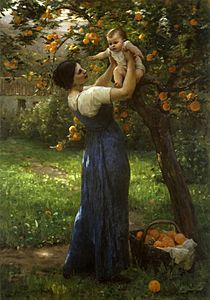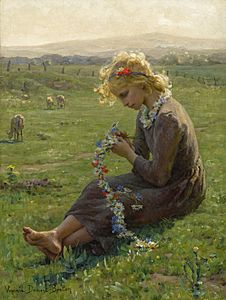Virginie Demont-Breton facts for kids
Quick facts for kids
Virginie Demont-Breton
|
|
|---|---|
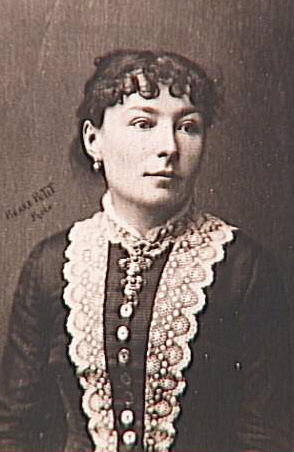
Virginie Demont-Breton around 1900, Photo by Pierre Petit
|
|
| Born |
Virginie Élodie Marie Thérèse Breton
26 July 1859 Courrières, France
|
| Died | 10 January 1935 (aged 75) Paris, France
|
| Nationality | French |
| Known for | Painting |
| Spouse(s) |
Adrien Demont
(m. 1880) |
Virginie Élodie Marie Thérèse Demont-Breton (born July 26, 1859, in Courrières – died January 10, 1935, in Paris) was a talented French painter. She is known for her realistic paintings, especially those showing the lives of fishermen and their families.
Contents
Who Was Virginie Demont-Breton?
Virginie Demont-Breton came from a family of artists. Her father, Jules Breton, and her uncle, Émile Breton, were both famous painters. Because of her family, Virginie met many other artists. One of the most important people she met was Rosa Bonheur, who became her role model and teacher.
Early Life and Artistic Beginnings
Virginie started her art career very early. She finished her first painting when she was only fourteen years old. By the time she was twenty, her art was shown at the important Salon exhibition in Paris. There, she received a special mention for her work.
Just four years later, she won a Gold Medal at the Amsterdam Exposition. This showed how quickly she became a recognized artist. In 1880, she married another painter named Adrien Demont.
Life in Wissant: A New Artistic Focus
In 1890, Virginie and her husband moved to Wissant. This was a small village located on the Côte d'Opale, which is a beautiful coast in France. They built a unique house there called the "Typhonium."
This house was designed in an ancient Egyptian style by a Belgian architect named Edmond De Vigne. The Typhonium has been recognized as a Historical Monument since 1985. Moving to Wissant changed the subjects Virginie painted.
Painting the Sea and Its People
Before moving to Wissant, Virginie mostly painted portraits and historical scenes. But after living by the sea, she started painting the local fishermen and their families. She used a realistic style to show their everyday lives.
She also painted many scenes of mothers and children. These paintings often showed mothers as strong and powerful figures in nature. One of her famous works, L’Homme Est en Mer (which means Her Man is Out to Sea), was even copied by the famous artist Vincent van Gogh in 1889.
Virginie's Impact on Women in Art
Virginie Demont-Breton was a leader for women artists. From 1895 to 1901, she was the President of the Union of Women Painters and Sculptors. She worked hard with Hélène Bertaux to help women get into the École des Beaux-Arts, a very important art school in France.
Their efforts paid off, and women were finally allowed to study there in 1897. Virginie was also honored with the Légion d'honneur in 1894. This is a very high award in France. She was only the second woman to receive it, after her mentor Rosa Bonheur. In 1914, she became an Officer of the Légion d'honneur.
Exhibiting Her Art in America
Virginie Demont-Breton's work was shown at the 1893 World's Columbian Exposition in Chicago, Illinois, USA. Her paintings were displayed in several important buildings there, including the Palace of Fine Arts, the Children's Building, and The Woman's Building. This helped her art become known to a wider audience.
Gallery
-
Her Man is at Sea (after Demont-Breton), by Vincent van Gogh, 1889
Writings
Virginie Demont-Breton also wrote books:
- Tendresses dans la tourmente. 1914-1919 poésies, Alphonse Lemerre, Paris 1920
- Les maisons que j'ai connues. Plon-Nourrit, Paris 1926
See also
 In Spanish: Virginie Demont-Breton para niños
In Spanish: Virginie Demont-Breton para niños


